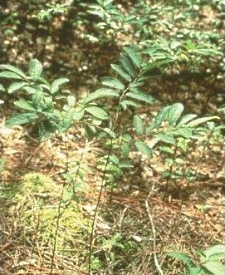Wildlife - Species

Pondberry (Lindera melissafolia)
Description
Pondberry belongs to the Laurel family (Lauraceae). It is a small, deciduous shrub (30-200 cm or 12-80 in tall) that is easily identified by the sassafras-like aroma of freshly crushed leaves. The leaves are thin and alternate, and their shape varies from oblong to oval, or a combination of the two. The tips of the leaves are somewhat pointed, and the bases are slightly tapered to rounded. The margins are entire, and the lower surface of the leaves is sparsely to densely covered with fine hairs. Flowers are dioecious (individual flowers have either male or female flower parts), small, and pale yellow. The fruits are nearly a half inch long and bright red at maturity.
Preferred Habitat and Biology
Pondberry is found in Arkansas, Missouri, and Mississippi and from North Carolina to Georgia. The species inhabits pond margins, swampy depressions, sandy sinks, and seasonally flooded wetlands. In South Carolina, pondberry grows along the margins of limestone sinks and shallow depressions. The plant also inhabits pinelands and recently burned open areas. Radford and others (1968) included Colleton County in the known distribution of pondberry, but Rayner (1984) did not find it during his survey.
The shrub generally grows in clones of numerous stems that are not highly branched. Clones expand vegetatively, eventually consisting of many well-rooted stems. The stems usually live about six or seven growing seasons, and new stems sprout from the base of dead stems; thus, a mature colony usually consists of numerous dead stems with younger leafy ones. Many populations consist predominately of male plants (only producing male flowers). Pondberry flowers bloom in the second to fourth years of growth. The clusters of yellow flowers bloom during February or March, before the leaves emerge. The fruits mature by late summer or fall, and each fruit produces one seed. However, very little data exist on the reproductive success of pondberry. A few studies indicate that insects, flies, wasps and small bees are the major pollinators, carrying pollen from the male flowers to the pistils of the females. The seeds are probably dispersed by mammals and birds and germinate during the next growing season.
Species Significance
Pondberry does not have any particular aesthetic value, nor are any horticultural, medicinal, or other economic uses known. Pondberry is a rare plant that was federally listed as endangered on July 31, 1986. Historically, the plant had a wider distribution, but only 37 populations of the species are currently found within its range. Fortunately, most of the plants are located on protected lands.
References
DeLay, L., R. O'Connor, J. Ryan, and R.R. Currie. 1993. Recovery plan for Pondberry (Lindera melissifolia [Walt.] Blume). U.S. Department of the Interior, Fish and Wildlife Service. Atlanta, GA.
Godfrey, R.K. and J.W. Wooten. 1981. Aquatic and wetland plants of southeastern United States: Dicotyledons. The University of Georgia Press, Athens, GA.
Radford, A.E., H.E. Ahles, and C.R. Bell. 1968. Manual of the vascular flora of the Carolinas. The University of North Carolina Press, Chapel Hill, NC.
Rayner, D.A. 1984. Inventory of botanical natural areas in Colleton County, South Carolina. SC Wildlife and Marine Resources Department, Division of Wildlife and Freshwater Fisheries, Columbia, SC.
Steyermark, J.A. 1949. Lindera melissifolia. Rhodera 51(608):153-162.
Tucker, G.E. 1984. Status report on Lindera melissifolia (Walt.) blume. U.S. Fish and Wildlife Service, Southeast Region, Atlanta, GA.
